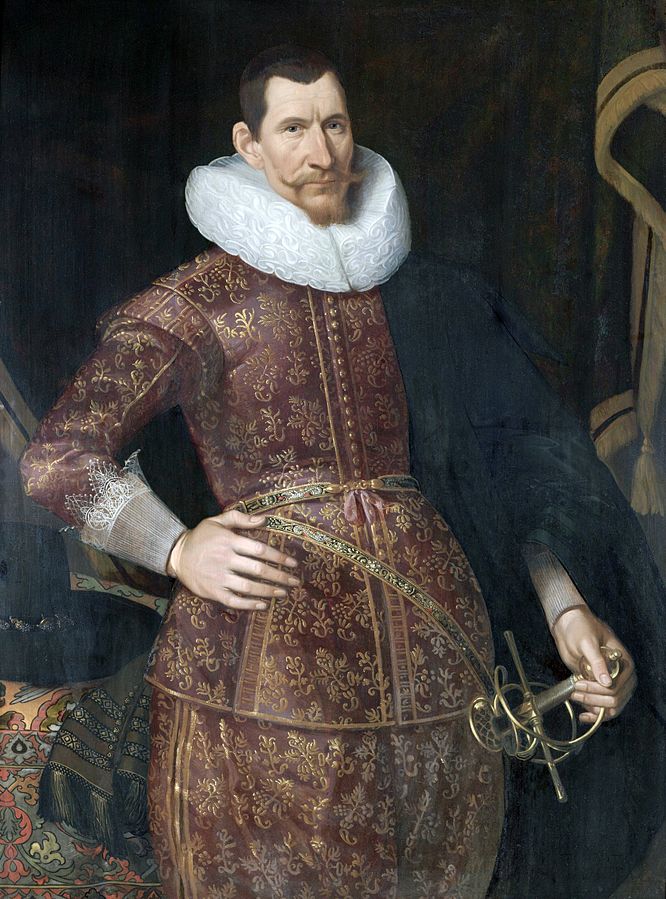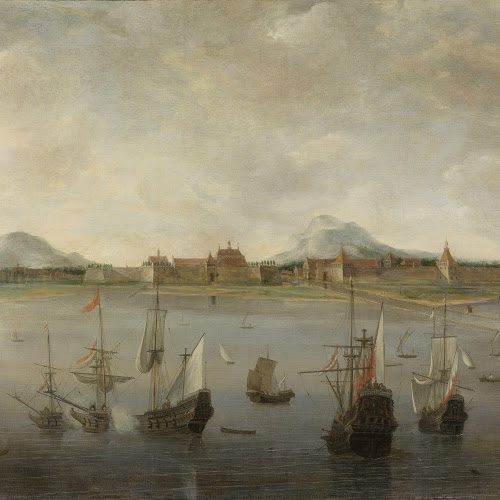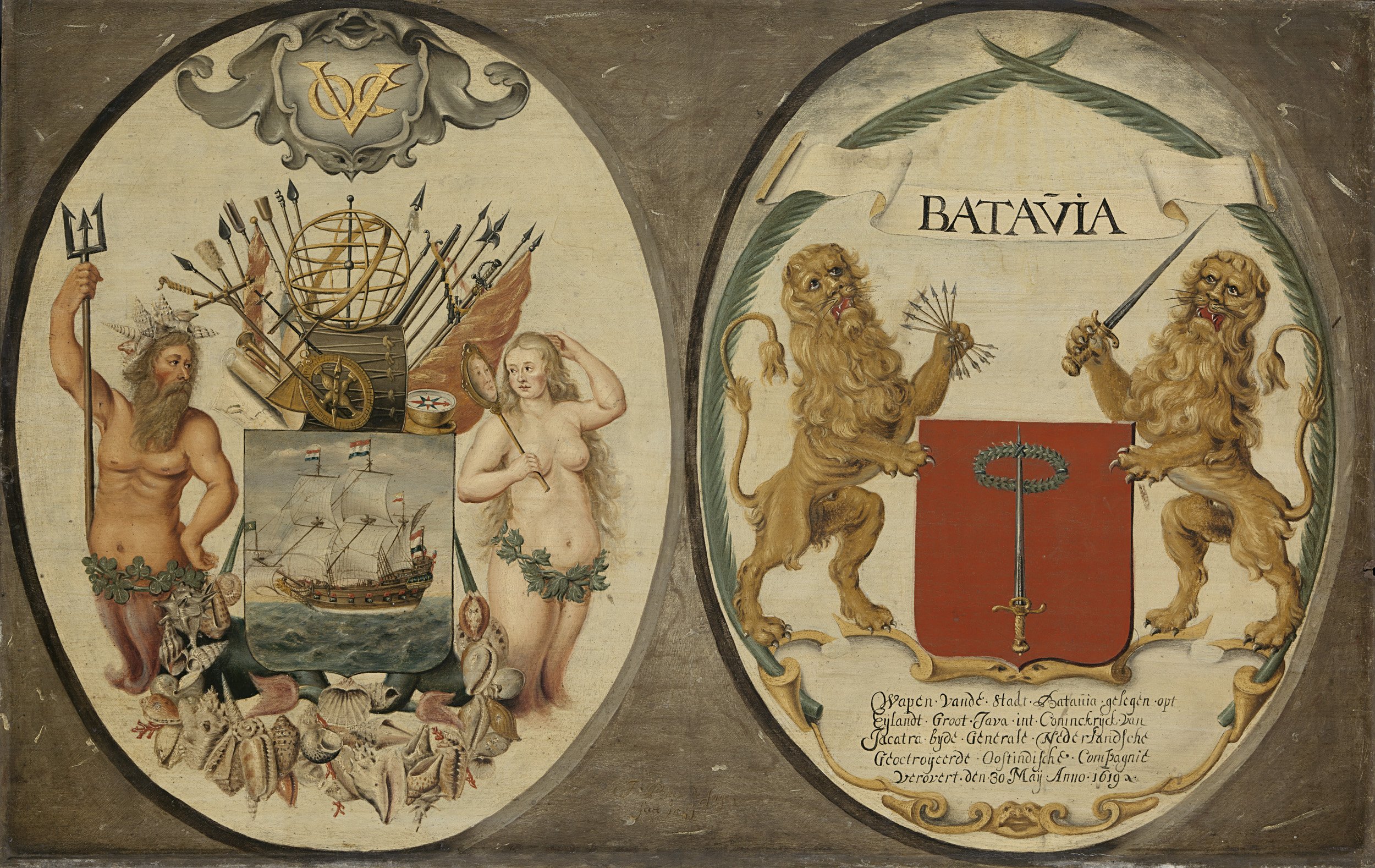Four hundred years ago, Governor-General Jan Pieterszoon Coen founded Batavia, creating a Dutch enclave on the island of Java.
But it nearly didn’t happen; thanks to the forceful resistance of Prince Jayawikarta.
Coen wanted to name the city “New Hoorn”, but Heeren XVII, who oversaw the VOC from Amsterdam, decided otherwise.
“May I pass through?” I ask the two men who are enjoying a plate of bakso with meatballs next to a food cart down a narrow alley. Speechless, they gaze at me in surprise. It often happens when Indonesians suddenly come face to face with a ‘bule’ – white man. “But there isn’t anything here,” says one of the men, while he shifts uncomfortably on his stool, wondering what this foreigner is doing in this desolate alley between a couple of ugly concrete buildings.
“There’s a tomb here isn’t there?” I persist. A glint of recognition appears on one of their faces. Surprised that I, a ‘bule’, have come specially for the tomb.
“Yes, at the end of the alley, you can’t miss it,” says one of the men. I thank them as I walk past them. The alley ends at a tiny mosque. I take my slippers off and walk into a space of 4 x 4 metres.
Three men are praying, murmuring “Allahu akbar”. They ignore me. In the corner of the prayer room is a box shaped structure made of cement and about a metre square with an open top. It is the final resting place of the Prince of Jayawikarta.
As I peer into it, I see a clean white sheet covering a formless mound; the sheet is covered with flowers. Could it be his bones? A small coffin maybe? I don’t dare touch it.
On one of the low walls of the tomb are three Koran book holders. So, people come here to pray for the Prince. This is where he could be, the man who once reigned over what is now the city of Jakarta, until 1619, 400 years ago.
At the time, a battle raged in this area that would determine the fate of the Indonesian Archipelago and the far-away Netherlands for centuries to come. Jayawikarta’s opponent was none other than the Dutch Governor Jan Pieterzoon Coen.
“Is this really where the Prince is?” I wondered to myself. There is another mosque in Jakarta that also claims to be the Prince’s resting place, even though it is now known to be the tomb of a later family member from the eighteenth century.
The authenticity of the remains in this small mosque are equally dubious though. No one really knows for sure where Jayawikarta drew his last breath. Even how he died, who he was, who is family were, are all a mystery. This of course makes him all the more legendary.
The only known fact is that he was the regent of Jakarta until the Dutch came. These foreigners were settling along the north coast of Java in the sixteenth century. The Javanese coast was where the workshops were. The lucrative trade in spices however, took place further east among the Moluccan islands.
Nevertheless, the Dutch East Indies company, the VOC, also wanted to use the Javanese coast for trade, storage and ship repairs. The hub for Javanese industry at the time lay in Bantam, some sixty kilometres to the west of Jakarta. Jakarta though, had a small but strategic warehouse on the east bank of the Ciliwung river. On the west bank lay the Dalem, the palace residence of the Prince and not far from a British factory, the biggest competitor of the Dutch East Indies company.
Jayawikarta was not an independent monarch, but a tributary of the ruler of Bantam, who in turn was too young to be a Prince. The real power was in the hands of a regent. This made the power relationship complex in the area. Coen, who then presided over all of the VOC’s Eastern regions, saw his opportunity in this delicate relationship between prince and regent. Coen had been devising a plan to create his own enclave on the North Javanese coast, thereby avoiding the hassles of dealing with a regent and prince. Why not in Jayawikarta’s territory?
“Something splendid will arise,” he wrote to the VOC back home, convincing them to follow through with his plan. These words would echo on for centuries. In Amsterdam Heeren XVII, who determined the VOC’s strategy, saw little merit in his plan of attack. It would only result in high costs and be disruptive for trade; until fate gave Coen a helping hand.
The British Armada
It’s hard to pinpoint what exactly are the causes and what are the effects of the events that occurred between 1618 and 1619. One thing was clear however: Coen saw the British strengthen their grip in the region by the day. The Dutch and the British had already clashed in Bantam, and Coen didn’t trust Jayawikarta.
He set out to expand the factory on the banks of the Ciliwung river. Its walls were widened and built up higher. The building, once a simple warehouse, almost unnoticeably transformed into a small fort. Once the Dutch placed their canons on the fortified walls and aimed directly at Jayawikarta’s Dalem, the Prince knew it was time to take action.
He had a trump card: the allied British arrived with a small armada at the Ciliwung estuary just before Christmas 1618. Had the Brits come because of the fort, or had they already planned to attack anyway? We’ll never know the reason.
Although Coen had far fewer ships at hand, he did have a strong fort. What was he to do? The Dutchman took a surprising course of action: he slipped away with a few ships to the Moluccan islands where the powerful VOC ships lay, loading for their return journey. He planned to return with enough soldiers to fight off the Brits.
Coen had left Pieter van den Broeke, his right-hand man, behind to defend the fort. Should he be forced to surrender, he was instructed to do so to the British: Coen distrusted the Javanese.
A short, tumultuous battle ensued after Coen’s departure. The powerful cannons shot repeatedly, destroying many of the British attackers, until Dutch gunpowder ran out. The firing quickly changed into a ground battle. The Dutch, with their slaves and Asian recruits, against the British and Jayawikarta.
Jayawikarta’s Trick
The day after my visit to Jayawikarta’s tomb I find myself in Kota Tua, Old Jakarta. The Jakarta Historical Museum now occupies the former City Hall. In the museum’s room of colonial history, I look at a diorama. The display showing a wall with figurines in white uniforms and wicker hats, these are clearly the Dutch. Below the wall stand figurines with darker complexions in loincloths: the Javanese.
The clothes on the figurines are far from historically accurate, but this set-up clearly shows their roles in the scheme of events. The Dutch could hold the fort with relative ease, while the Javanese waited for their opportunity to strike. The Javanese could have altered the course of the river, leaving the fort without water. But instead, Jayawikarta decided to win the battle with another trick. The Prince proposed a cease-fire to Coen’s replacement Pieter van den Broeke, supposedly to prevent further bloodshed.
In exchange for a payment of 6000 silver reales by the Dutch, the Prince was willing to cease all hostilities and send the British packing. On Coen’s return they would sign a definitive truce. Pieter van den Broeke agreed, possibly to buy some time.
However, when Van den Broeke arrived at Jayawikarta’s palace with the money, he was taken prisoner. The prince had changed his stance, possibly because the British had advised him that the Dutch had a plan up their sleeve. Whatever the reason, Van den Broecke and his men were captured and imprisoned.
In one fortnight, the Dutch fort had now lost its second commander.
Now the chief merchant, Pieter van Raey, took over as commander of the demoralised crew of the Dutch fort. Jayawikarta began threatening to kill his Dutch prisoners painfully, should the men in the fort not turn themselves in. Two weeks after the capture of Van de Broeke and his men, Van Raey started negotiating the terms of a surrender.
The events that unfolded afterwards still remain a mystery, but certain is that the Regent of Bantam was not happy with the battle between his subordinate, Jayawikarta, and the VOC. In order to prevent losing his lucrative trade with the VOC he sent his own Bantam army to the Ciliwung estuary and dethroned Jayawikarta.
As legend has it, he did this with a kris held to the ex-prince’s chest, the ultimate insult for Javanese royalty. The regent of Bantam then continued the negotiations with the Dutch.
Just as the talks began, Coen returned with the VOC fleet, four months after fleeing Jakarta. He was in no mood to negotiate with the regent. He took control of the fort, then crossed the river, fighting off the regent’s army, and continued to set light to the palace. The flames from the palace spread to the neighbouring houses.
Soon, the small city of Jakarta was gone. The British packed up and left.
Shortly after, Coen started building the fort into a veritable castle. He wanted to call it “New Hoorn”, after his home town in Holland, but Heeren XVII decided otherwise: “Batavia” would be its new name, after the Germanic tribe who once lived in the Netherlands.
What about Jayawikarta? Some Indonesian history books claim he fled the region with a few trusted comrades, chased by Dutch soldiers. He died a martyr in Bogor. No one knows for sure if this is what happened.
His body was subsequently taken by his servants to the small, secret mosque just outside the city of Batavia. Within four centuries, as a huge metropolis developed, the mosque was gradually enveloped by apartment and office blocks.
Since Indonesia’s Independence, Jayawikarta’s legend has enjoyed a revival; now counting two tombs, a station, and many streets being named after him. Not to forget the city of Jakarta that also bears his name, after several centuries of being called Batavia.
Coen, yesteryear’s victor, today has a dubious and bloody reputation. A school in Amsterdam, named after Coen, recently decided to choose a new name. A tunnel in the region might befall the same fate.
This too is history. Former heroes fall off their pedestal, while those that were considered losers, sometimes posthumously get their revenge.
Batavia was mainly Asian
In 1619, Coen had a large city in mind. He was keen to see rich businessmen come: “prim and proper people with lots of money”. This would spur the growth of a city as large as Amsterdam, in the far East.
Unfortunately, his plan failed. There was little reason for businessmen to come. The VOC dominated international trade. The journey to Batavia was dangerous, just as living there was.
At the time of Coen’s death in 1629, the city had a population of 8000, a quarter of them were European, the rest were Asian. By the beginning of the eighteenth century, Batavia’s population had grown to 50,000. The share of Dutch inhabitants had dropped, giving way to more Asians of Chinese, Buginese (Sulawesi), Balinese, and Mardijkers (Portuguese) descent. These were mainly freed slaves.
The castle that Coen built was dismantled by the Dutch in the nineteenth century, but surrounding the 1710 Dutch City Hall are several historic buildings.
The former harbour has a few restored VOC warehouse buildings. Most of the remaining colonial buildings, built around the nineteenth and twentieth century, lie further south near the National Monument, ‘Monas’.
Today, these beautiful former country mansions, are used as government or corporate offices. Perhaps the best example of Dutch colonial architecture is the National Museum, which formerly housed the Batavian Association for Arts and Sciences.
A visitor wanting to visit Jakarta’s many historic buildings will need to reserve roughly one week to visit them all.
By Philip Dröge
Philip Dröge is a Dutch journalist, quarter Indonesian, living in Amsterdam.
Translated by Thierry Sanders, Jakarta
Initially published in Dutch in the “Historisch Nieuwsblad” March 2019. No.3.
Image: Rijkmuseum





